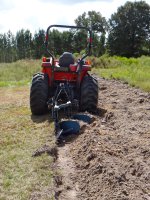I'm not sure why the pins on either side of the 3 pt hitch are at different levels horizontally.
When plowing with a moldboard plow, the right front and right rear wheel of your tractor are deep in the plow furrow. Tractor will be well canted to the right. The offset pins maintain the plow approximately level even though your right front and right rear wheels are deep in a furrow. Plow fills right furrow as tractor move down the field. All (?) moldboard plows have similar offset draw pins. Photo #1
The plow has minimal ways to adjust it, very minimal.
Plows are adjusted through the tractor Three Point Hitch
Top Link and adjustable right
Lifting Rod. The plow should be level horizontally and front to back. To encourage plow to penetrate deeper, known as plow "suck", adjust the Top Link shorter. To make plow run shallower, lengthen Top Link.
~~~~just 1/2 turn changes, this is FINE tuning.
Level plow (with right tires in furrow) with adjustable right Lifting Rod. Check level with a 6" Topedo level, rather than by eye.
ILLUSTRATION:
CountyLine Lift Arm Leveling Assembly - For Life Out Here
Is this considered a "good"plow or is it inferior to Ford, Dearborn, Ferguson, and Oliver plows?
Plow brand is much less important than
plow condition and
operator experience. Only proficient plowmen can discern field differences in plow brands. At beginner's level all plow brands are equally cantankerous.
The Deere seems to be balky when using. Moldboard plowing is one of the most time consuming implement skills to learn. You may need 100 hours of contemplative plowing to become proficient. A single bottom moldboard plow is the easiest to use and adjust. The more bottoms, the more complex adjustment.
Rust on the moldboard will make a plow balky, Moldboard should be bright and shiny. Further plowing will scrub off rust. Grease plow moldboard between uses, paint before storing for several months. Rust leads to pitting.
Dull, worn or bent wear parts make a plow balky.
If your Holder tractor has four equal size wheels, it will not have the "grunt" of a tractor plowing with jumbo rear wheels giving a more forward weight bias.
While driving along with the bottom down, it can, sometimes for no apparent reason, pop up and no longer be digging a furrow.
This is your (plow) Draft Control at work. Most older and almost all ag tractors have Draft Control as an integral part of Three Point Hitch hydraulics. You adjust Draft Control sensitivity by moving inboard end of the Top Link up and down the three or four possible positions on the rear of the tractor. You fine tune Draft Control adjustment with the Draft Control lever. I am not familiar with Holders, but on most tractors the Draft Control lever is inboard of the Postion Control lever.
I have a Holder tractor.
This info should be in your TBN profile, along with the Holder model number, so it shows in every post. Your location should also be in your profile so we know something about your soil, rainfall, rainfall distribution, temperatures, growing season, altitude and regional equipment suppliers. As you have a Holder, you are probably in Canada.
Where should the plow be placed relative to the tire width?
Right of center. Start with a 14" gap between right side of plow and right rear tractor tire. The single bottom plow fills furrow behind right-rear tractor wheel.
There is a way to loosen some bolts and move the plow either right or left.
Most plows have this adjustment as part of the plow frame. I am not familiar with the Deere Model 25. Post pictures.
This would maximinze the furrow width, 14" in the case of the Deere plow.
Work on maintaining a consistent furrow depth. Width will take care of itself. Plows are inflexible about furrow depth. A 14" moldboard plow will only correctly cut, turn and layover dirt/verdure in the narrow depth range of 6" to 8".
MORE: http://www.tractorbynet.com/forums/...oard-plow-wisdom-farmwithjunk.html?highlight=
MORE, MORE: Google


